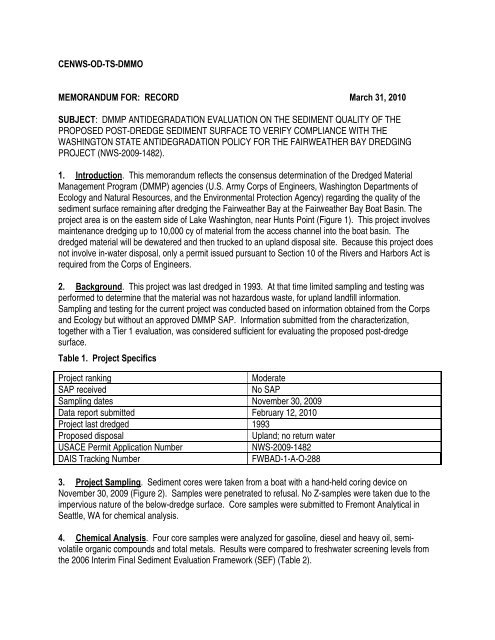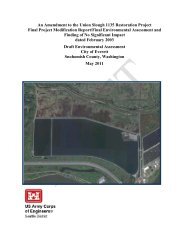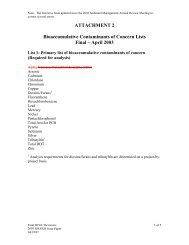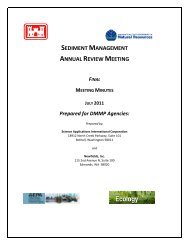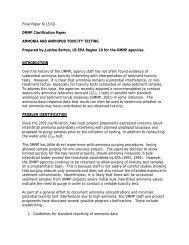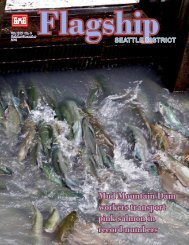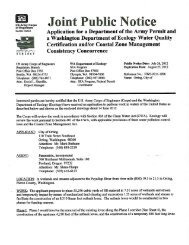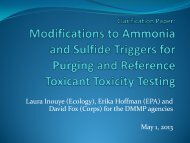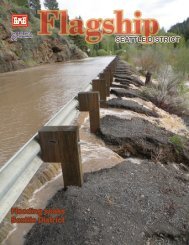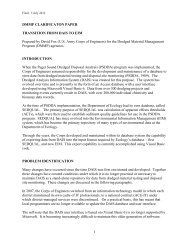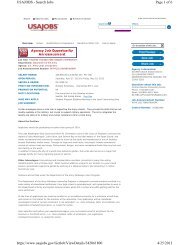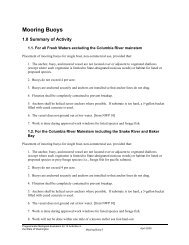CENWS-OD-TS-DMMO MEMORANDUM FOR ... - Seattle District
CENWS-OD-TS-DMMO MEMORANDUM FOR ... - Seattle District
CENWS-OD-TS-DMMO MEMORANDUM FOR ... - Seattle District
Create successful ePaper yourself
Turn your PDF publications into a flip-book with our unique Google optimized e-Paper software.
<strong>CENWS</strong>-<strong>OD</strong>-<strong>TS</strong>-<strong>DMMO</strong><br />
<strong>MEMORANDUM</strong> <strong>FOR</strong>: RECORD March 31, 2010<br />
SUBJECT: DMMP ANTIDEGRADATION EVALUATION ON THE SEDIMENT QUALITY OF THE<br />
PROPOSED POST-DREDGE SEDIMENT SURFACE TO VERIFY COMPLIANCE WITH THE<br />
WASHINGTON STATE ANTIDEGRADATION POLICY <strong>FOR</strong> THE FAIRWEATHER BAY DREDGING<br />
PROJECT (NWS-2009-1482).<br />
1. Introduction. This memorandum reflects the consensus determination of the Dredged Material<br />
Management Program (DMMP) agencies (U.S. Army Corps of Engineers, Washington Departments of<br />
Ecology and Natural Resources, and the Environmental Protection Agency) regarding the quality of the<br />
sediment surface remaining after dredging the Fairweather Bay at the Fairweather Bay Boat Basin. The<br />
project area is on the eastern side of Lake Washington, near Hunts Point (Figure 1). This project involves<br />
maintenance dredging up to 10,000 cy of material from the access channel into the boat basin. The<br />
dredged material will be dewatered and then trucked to an upland disposal site. Because this project does<br />
not involve in-water disposal, only a permit issued pursuant to Section 10 of the Rivers and Harbors Act is<br />
required from the Corps of Engineers.<br />
2. Background. This project was last dredged in 1993. At that time limited sampling and testing was<br />
performed to determine that the material was not hazardous waste, for upland landfill information.<br />
Sampling and testing for the current project was conducted based on information obtained from the Corps<br />
and Ecology but without an approved DMMP SAP. Information submitted from the characterization,<br />
together with a Tier 1 evaluation, was considered sufficient for evaluating the proposed post-dredge<br />
surface.<br />
Table 1. Project Specifics<br />
Project ranking<br />
Moderate<br />
SAP received<br />
No SAP<br />
Sampling dates November 30, 2009<br />
Data report submitted February 12, 2010<br />
Project last dredged 1993<br />
Proposed disposal<br />
Upland; no return water<br />
USACE Permit Application Number<br />
NWS-2009-1482<br />
DAIS Tracking Number<br />
FWBAD-1-A-O-288<br />
3. Project Sampling. Sediment cores were taken from a boat with a hand-held coring device on<br />
November 30, 2009 (Figure 2). Samples were penetrated to refusal. No Z-samples were taken due to the<br />
impervious nature of the below-dredge surface. Core samples were submitted to Fremont Analytical in<br />
<strong>Seattle</strong>, WA for chemical analysis.<br />
4. Chemical Analysis. Four core samples were analyzed for gasoline, diesel and heavy oil, semivolatile<br />
organic compounds and total metals. Results were compared to freshwater screening levels from<br />
the 2006 Interim Final Sediment Evaluation Framework (SEF) (Table 2).
5. DMMP Antidegradation Evaluation. To evaluate the concern for post dredging surface degradation,<br />
chemical results of the proposed dredged material were compared with interim freshwater guidelines from<br />
the RSET Sediment Evaluation Framework (RSET 2009). No exceedances of freshwater guidelines for the<br />
chemicals of concern were found in the dredged material, and there are no indications that there is<br />
increasing contamination with depth. Some DMMP chemicals of concern were not analyzed for in this<br />
characterization, including PCBs and dioxins. Tier 1 analysis of the dredge area showed little reason-tobelieve<br />
for post-dredge surface contamination of either of those classes of chemicals, so no additional<br />
sampling was required to verify compliance with state antidegradation standards. However, this evaluation<br />
does not support any in-water disposal of dredged sediments.<br />
6. Upland disposal locations. The Best Management Practices detailed in the JARPA for dewatering<br />
dredged material before upland disposal are encouraged and supported. For further guidance as to<br />
potential upland disposal the applicant should consult the local health district for guidance.<br />
7. References.<br />
Fremont Analytical, 2009. Fairweather Bay Dredging Project analytical report. December 7, 2009<br />
RSET, 2009. Northwest Regional Sediment Evaluation Framework. . Northwest Regional Sediment<br />
Evaluation Team, May 2009.
Table 2. Results of Chemical Analysis for Fairweather Bay.<br />
Interim FW SQG<br />
Sample<br />
CHEMICAL SL1 SL2<br />
1<br />
Sample<br />
2<br />
Sample<br />
3<br />
Sample<br />
4<br />
METALS<br />
mg/kg dry wt.<br />
Antimony --- --- nd 0.3 nd nd<br />
Arsenic 20 51 6.3 8.1 5.0 5.0<br />
Cadmium 1.1 1.5 0.25 0.47 0.40 0.25<br />
Chromium 95 100 25 22 39 23<br />
Copper 80 830 25 31 22 17<br />
Lead 340 430 5.6 37 6.5 19<br />
Mercury 0.28 0.75 nd nd nd nd<br />
Nickel 60 70 23 16 42 27<br />
Selenium --- --- nd nd nd nd<br />
Silver 2.0 2.5 nd nd 0.33 nd<br />
Zinc 130 400 63 103 55 37<br />
ORGANICS<br />
µg/kg dry wt.<br />
Total LPAH 6,600 9,200 nd 640 5 811<br />
Naphthalene 500 1,300 nd nd 5.00 6.0<br />
Acenaphthylene 470 640 nd nd nd 15.0<br />
Acenaphthene 1,100 1,300 nd nd nd 70<br />
Fluorene 1,000 3,000 nd nd nd 60<br />
Phenanthrene 6,100 7,600 nd 190 nd 340<br />
Anthracene 1,200 1,600 nd 450 nd 320<br />
2-Methylnaphthalene 470 560 nd nd nd 5.0<br />
Total HPAH 31,000 55,000 nd 3,280 nd 3,655<br />
Fluoranthene 11,000 15,000 nd 450 nd nd<br />
Pyrene 8,800 16,000 nd 390 nd 650<br />
Benzo(a)anthracene 4,300 5,800 nd 150 nd 1150<br />
Chrysene 5,900 6,400 nd 220 nd 500<br />
600 4,000 nd 250 nd 250<br />
Benzofluoranthenes (b+j+k) --- ---<br />
--- --- nd 420 nd 380<br />
Benzo(a)pyrene 3,300 4,800 nd 170 nd 170<br />
Indeno(1,2,3-c,d)pyrene 4,100 5,300 nd 1100 nd 490<br />
Dibenz(a,h)anthracene 800 840 nd nd nd 15<br />
Benzo(g,h,i)perylene 4,000 5,200 nd 130 nd 50<br />
CHLORINATED HYDROCARBONS<br />
µg/kg dry wt.<br />
1,3-Dichlorobenzene --- --- nd nd nd nd<br />
1,4-Dichlorobenzene --- --- nd nd nd nd<br />
1,2-Dichlorobenzene --- --- nd nd nd nd<br />
1,2,4-Trichlorobenzene --- --- nd nd nd nd<br />
Hexachlorobenzene (HCB) --- --- nd nd nd nd
Interim FW SQG<br />
CHEMICAL SL1 SL2<br />
Sample<br />
1<br />
Sample<br />
2<br />
Sample<br />
3<br />
Sample<br />
4<br />
PHTHALATES<br />
μg/kg dry wt.<br />
Dimethyl phthalate 46 440 nd nd nd nd<br />
Diethyl phthalate --- --- nd nd nd nd<br />
Di-n-butyl phthalate --- --- nd nd nd nd<br />
Butyl benzyl phthalate 260 370 nd nd nd nd<br />
Bis(2-ethylhexyl) phthalate 220 320 nd nd nd nd<br />
Di-n-octyl phthalate 26 45 nd nd nd nd<br />
PHENOLS<br />
µg/kg dry wt.<br />
Phenol --- --- nd nd nd nd<br />
2-Methylphenol --- --- nd nd nd nd<br />
4-Methylphenol --- --- nd nd nd nd<br />
2,4-Dimethylphenol --- --- nd nd nd nd<br />
Pentachlorophenol --- --- nd nd nd nd<br />
MISCELLANEOUS EXTRACTABLES<br />
µg/kg dry wt.<br />
Benzyl alcohol --- --- nd nd nd nd<br />
Benzoic acid --- --- nd nd nd nd<br />
Dibenzofuran 400 440 nd nd nd nd<br />
Hexachloroethane --- --- nd nd nd nd<br />
Hexachlorobutadiene --- --- nd nd nd nd<br />
Notes:<br />
All non-detects were at or below Interim FW SQGs<br />
2-Methylnaphthalene is not included in sum of LPAHs


